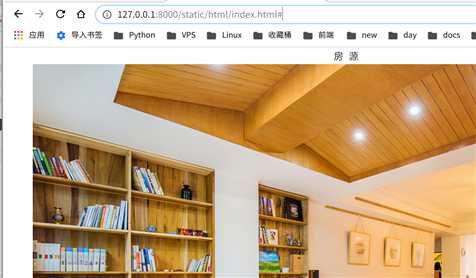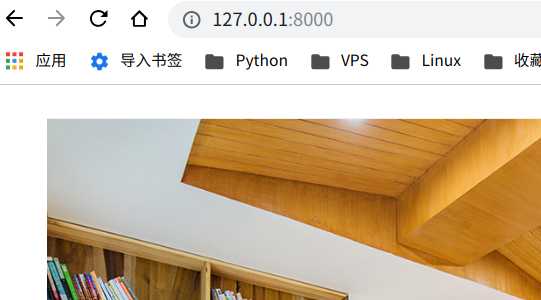标签:title 空间 core url print page filename 模板 类的构造函数
现在有一个预先写好的静态页面文件 (下载静态文件资源), 我们来看下如何用tornado提供静态文件。
我们可以通过向web.Application类的构造函数传递一个名为static_path的参数来告诉Tornado从文件系统的一个特定位置提供静态文件,如:
app = tornado.web.Application( [(r‘/‘, IndexHandler)], static_path=os.path.join(os.path.dirname(__file__), "static"), )
在这里,我们设置了一个当前应用目录下名为statics的子目录作为static_path的参数。现在应用将以读取statics目录下的filename.ext来响应诸如/static/filename.ext的请求,并在响应的主体中返回。

对于静态文件目录的命名,为了便于部署,建议使用static
对于我们提供的静态文件资源,可以通过http://127.0.0.1/static/html/index.html来访问。而且在index.html中引用的静态资源文件,我们给定的路径也符合/static/...的格式,故页面可以正常浏览。
<link href="/static/plugins/bootstrap/css/bootstrap.min.css" rel="stylesheet"> <link href="/static/plugins/font-awesome/css/font-awesome.min.css" rel="stylesheet"> <link href="/static/css/reset.css" rel="stylesheet"> <link href="/static/css/main.css" rel="stylesheet"> <link href="/static/css/index.css" rel="stylesheet"> <script src="/static/js/jquery.min.js"></script> <script src="/static/plugins/bootstrap/js/bootstrap.min.js"></script> <script src="/static/js/index.js"></script>
我们再看刚刚访问页面时使用的路径http://127.0.0.1/static/html/index.html,这中url显然对用户是不友好的,访问很不方便。我们可以通过tornado.web.StaticFileHandler来自由映射静态文件与其访问路径url。
tornado.web.StaticFileHandler是tornado预置的用来提供静态资源文件的handler。
# -*- coding: utf-8 -*- # __auther__ = ‘lewen‘ import os import tornado.web import tornado.ioloop import tornado.httpserver from tornado.web import RequestHandler, url, StaticFileHandler from tornado.options import options, define define("port", default=8000, type=int, help="run the server on the port") class IndexHandler(RequestHandler): def get(self, *args, **kwargs): pass if __name__ == "__main__": tornado.options.parse_command_line() current_path = os.path.dirname(__file__) app = tornado.web.Application([ (r‘/(.*)‘, StaticFileHandler, {"path": os.path.join(current_path, "static/html"), "default_filename": "index.html"}), # (r‘^/view/(.*)$‘, StaticFileHandler, {"path": os.path.join(current_path, "static/html")}), ], debug=True, # static_path=os.path.join(os.path.dirname(__file__), "static"), ) http_server = tornado.httpserver.HTTPServer(app) http_server.listen(options.port) tornado.ioloop.IOLoop.current().start()
path 用来指明提供静态文件的根路径,并在此目录中寻找在路由中用正则表达式提取的文件名。
default_filename 用来指定访问路由中未指明文件名时,默认提供的文件。
现在,对于静态文件statics/html/index.html,可以通过三种方式进行访问:

statics 静态文件夹跟http://127.0.0.1:8000/static/html/index.html# 中的static(默认访问路径) 不一样
访问http://127.0.0.1:8000/static 时tornado会转换去对应的设置文件夹去找
部署时,将静态文件放到 nginx 上为了方便查找及引用,改为 static
使用模板,需要仿照静态文件路径设置一样,向web.Application类的构造函数传递一个名为template_path的参数来告诉Tornado从文件系统的一个特定位置提供模板文件,如:
app = tornado.web.Application( [(r‘/‘, IndexHandler)], static_path=os.path.join(os.path.dirname(__file__), "static"), template_path=os.path.join(os.path.dirname(__file__), "template"), )
在这里,我们设置了一个当前应用目录下名为templates的子目录作为template_path的参数。在handler中使用的模板将在此目录中寻找。
现在我们将静态文件目录statics/html中的index.html复制一份到templates目录中,此时文件目录结构为:

. ├── statics │ ├── css │ │ ├── index.css │ │ ├── main.css │ │ └── reset.css │ ├── html │ │ └── index.html │ ├── images │ │ ├── home01.jpg │ │ ├── home02.jpg │ │ ├── home03.jpg │ │ └── landlord01.jpg │ ├── js │ │ ├── index.js │ │ └── jquery.min.js │ └── plugins │ ├── bootstrap │ │ └─... │ └── font-awesome │ └─... ├── templates │ └── index.html └── test.py
在handler中使用render()方法来渲染模板并返回给客户端。
class IndexHandler(RequestHandler): def get(self): self.render("index.html") # 渲染主页模板,并返回给客户端。 current_path = os.path.dirname(__file__) app = tornado.web.Application( [ (r‘^/$‘, IndexHandler), (r‘^/view/(.*)$‘, StaticFileHandler, {"path":os.path.join(current_path, "statics/html")}), ], static_path=os.path.join(current_path, "statics"), template_path=os.path.join(os.path.dirname(__file__), "templates"), )
在tornado的模板中使用{{}}作为变量或表达式的占位符,使用render渲染后占位符{{}}会被替换为相应的结果值。
我们将index.html中的一条房源信息记录
<li class="house-item"> <a href=""><img src="/static/images/home01.jpg"></a> <div class="house-desc"> <div class="landlord-pic"><img src="/static/images/landlord01.jpg"></div> <div class="house-price">¥<span>398</span>/晚</div> <div class="house-intro"> <span class="house-title">宽窄巷子+160平大空间+文化保护区双地铁</span> <em>整套出租 - 5分/6点评 - 北京市丰台区六里桥地铁</em> </div> </div> </li>
改为模板: <li class="house-item"> <a href=""><img src="/static/images/home01.jpg"></a> <div class="house-desc"> <div class="landlord-pic"><img src="/static/images/landlord01.jpg"></div> <div class="house-price">¥<span>{{price}}</span>/晚</div> <div class="house-intro"> <span class="house-title">{{title}}</span> <em>整套出租 - {{score}}分/{{comments}}点评 - {{position}}</em> </div> </div> </li>
渲染方式如下: class IndexHandler(RequestHandler): def get(self): house_info = { "price": 398, "title": "宽窄巷子+160平大空间+文化保护区双地铁", "score": 5, "comments": 6, "position": "北京市丰台区六里桥地铁" } self.render("index.html", **house_info)
{{ }}不仅可以包含变量,还可以是表达式,可以加减,如:
<li class="house-item"> <a href=""><img src="/static/images/home01.jpg"></a> <div class="house-desc"> <div class="landlord-pic"><img src="/static/images/landlord01.jpg"></div> <div class="house-price">¥<span>{{p1 + p2}}</span>/晚</div> <div class="house-intro"> <span class="house-title">{{"+".join(titles)}}</span> <em>整套出租 - {{score}}分/{{comments}}点评 - {{position}}</em> </div> </div> </li> class IndexHandler(RequestHandler): def get(self): house_info = { "p1": 198, "p2": 200, "titles": ["宽窄巷子", "160平大空间", "文化保护区双地铁"], "score": 5, "comments": 6, "position": "北京市丰台区六里桥地铁" } self.render("index.html", **house_info)
可以在Tornado模板中使用Python条件和循环语句。控制语句以{%和%}包围,并以类似下面的形式被使用:
{% if page is None %}
或
{% if len(entries) == 3 %}
控制语句的大部分就像对应的Python语句一样工作,支持if、for、while,注意end:
{% if ... %} ... {% elif ... %} ... {% else ... %} ... {% end %}
{% for ... in ... %} ... {% end %}
{% while ... %} ... {% end %}
再次修改index.html:

<ul class="house-list"> {% if len(houses) > 0 %} {% for house in houses %} <li class="house-item"> <a href=""><img src="/static/images/home01.jpg"></a> <div class="house-desc"> <div class="landlord-pic"><img src="/static/images/landlord01.jpg"></div> <div class="house-price">¥<span>{{house["price"]}}</span>/晚</div> <div class="house-intro"> <span class="house-title">{{house["title"]}}</span> <em>整套出租 - {{house["score"]}}分/{{house["comments"]}}点评 - {{house["position"]}}</em> </div> </div> </li> {% end %} {% else %} 对不起,暂时没有房源。 {% end %} </ul>
python中渲染语句为:

class IndexHandler(RequestHandler): def get(self): houses = [ { "price": 398, "title": "宽窄巷子+160平大空间+文化保护区双地铁", "score": 5, "comments": 6, "position": "北京市丰台区六里桥地铁" }, { "price": 398, "title": "宽窄巷子+160平大空间+文化保护区双地铁", "score": 5, "comments": 6, "position": "北京市丰台区六里桥地铁" }, { "price": 398, "title": "宽窄巷子+160平大空间+文化保护区双地铁", "score": 5, "comments": 6, "position": "北京市丰台区六里桥地铁" }, { "price": 398, "title": "宽窄巷子+160平大空间+文化保护区双地铁", "score": 5, "comments": 6, "position": "北京市丰台区六里桥地铁" }, { "price": 398, "title": "宽窄巷子+160平大空间+文化保护区双地铁", "score": 5, "comments": 6, "position": "北京市丰台区六里桥地铁" }] self.render("index.html", houses=houses)
static_url()
Tornado模板模块提供了一个叫作static_url的函数来生成静态文件目录下文件的URL。如下面的示例代码:
<link rel="stylesheet" href="{{ static_url("style.css") }}">
这个对static_url的调用生成了URL的值,并渲染输出类似下面的代码:
<link rel="stylesheet" href="/static/style.css?v=ab12">
优点:
转义
我们新建一个表单页面new.html <!DOCTYPE html> <html> <head> <title>新建房源</title> </head> <body> <form method="post"> <textarea name="text"></textarea> <input type="submit" value="提交"> </form> {{text}} </body> </html>
对应的handler为: class NewHandler(RequestHandler): def get(self): self.render("new.html", text="") def post(self): text = self.get_argument("text", "") print text self.render("new.html", text=text) 当我们在表单中填入如下内容时: <script>alert("hello!");</script>

写入的js程序并没有运行,而是显示出来了:

我们查看页面源代码,发现<、>、"等被转换为对应的html字符。
<script>alert("hello!");</script>
这是因为tornado中默认开启了模板自动转义功能,防止网站受到恶意攻击。
我们可以通过raw语句来输出不被转义的原始格式,如:
{% raw text %}
注意:在Firefox浏览器中会直接弹出alert窗口,而在Chrome浏览器中,需要set_header("X-XSS-Protection", 0)
若要关闭自动转义,一种方法是在Application构造函数中传递autoescape=None,另一种方法是在每页模板中修改自动转义行为,添加如下语句:
{% autoescape None %}
escape()
关闭自动转义后,可以使用escape()函数来对特定变量进行转义,如:
{{ escape(text) }}
自定义函数
在模板中还可以使用一个自己编写的函数,只需要将函数名作为模板的参数传递即可,就像其他变量一样。
我们修改后端如下:
def house_title_join(titles): return "+".join(titles) class IndexHandler(RequestHandler): def get(self): house_list = [ { "price": 398, "titles": ["宽窄巷子", "160平大空间", "文化保护区双地铁"], "score": 5, "comments": 6, "position": "北京市丰台区六里桥地铁" }, { "price": 398, "titles": ["宽窄巷子", "160平大空间", "文化保护区双地铁"], "score": 5, "comments": 6, "position": "北京市丰台区六里桥地铁" }] self.render("index.html", houses=house_list, title_join = house_title_join)
前段模板我们修改为:

<ul class="house-list"> {% if len(houses) > 0 %} {% for house in houses %} <li class="house-item"> <a href=""><img src="/static/images/home01.jpg"></a> <div class="house-desc"> <div class="landlord-pic"><img src="/static/images/landlord01.jpg"></div> <div class="house-price">¥<span>{{house["price"]}}</span>/晚</div> <div class="house-intro"> <span class="house-title">{{title_join(house["titles"])}}</span> <em>整套出租 - {{house["score"]}}分/{{house["comments"]}}点评 - {{house["position"]}}</em> </div> </div> </li> {% end %} {% else %} 对不起,暂时没有房源。 {% end %} </ul>
我们可以使用块来复用模板,块语法如下:
{% block block_name %} {% end %}
现在,我们对模板index.html进行抽象,抽离出父模板base.html如下:

<!DOCTYPE html>
<html>
<head>
<meta charset="utf-8">
<meta http-equiv="X-UA-Compatible" content="IE=edge">
<meta name="viewport" content="width=device-width, initial-scale=1, maximum-scale=1, user-scalable=no">
{% block page_title %}{% end %}
<link href="{{static_url(‘plugins/bootstrap/css/bootstrap.min.css‘)}}" rel="stylesheet">
<link href="{{static_url(‘plugins/font-awesome/css/font-awesome.min.css‘)}}" rel="stylesheet">
<link href="{{static_url(‘css/reset.css‘)}}" rel="stylesheet">
<link href="{{static_url(‘css/main.css‘)}}" rel="stylesheet">
{% block css_files %}{% end %}
</head>
<body>
<div class="container">
<div class="top-bar">
{% block header %}{% end %}
</div>
{% block body %}{% end %}
<div class="footer">
{% block footer %}{% end %}
</div>
</div>
<script src="{{static_url(‘js/jquery.min.js‘)}}"></script>
<script src="{{static_url(‘plugins/bootstrap/js/bootstrap.min.js‘)}}"></script>
{% block js_files %}{% end %}
</body>
</html>
而子模板index.html使用extends来使用父模板base.html,如下:

{% extends "base.html" %}
{% block page_title %}
<title>爱家-房源</title>
{% end %}
{% block css_files %}
<link href="{{static_url(‘css/index.css‘)}}" rel="stylesheet">
{% end %}
{% block js_files %}
<script src="{{static_url(‘js/index.js‘)}}"></script>
{% end %}
{% block header %}
<div class="nav-bar">
<h3 class="page-title">房 源</h3>
</div>
{% end %}
{% block body %}
<ul class="house-list">
{% if len(houses) > 0 %}
{% for house in houses %}
<li class="house-item">
<a href=""><img src="/static/images/home01.jpg"></a>
<div class="house-desc">
<div class="landlord-pic"><img src="/static/images/landlord01.jpg"></div>
<div class="house-price">¥<span>{{house["price"]}}</span>/晚</div>
<div class="house-intro">
<span class="house-title">{{title_join(house["titles"])}}</span>
<em>整套出租 - {{house["score"]}}分/{{house["comments"]}}点评 - {{house["position"]}}</em>
</div>
</div>
</li>
{% end %}
{% else %}
对不起,暂时没有房源。
{% end %}
</ul>
{% end %}
{% block footer %}
<p><span><i class="fa fa-copyright"></i></span>爱家租房 享受家的温馨</p>
{% end %}
标签:title 空间 core url print page filename 模板 类的构造函数
原文地址:https://www.cnblogs.com/wenyule/p/10354635.html